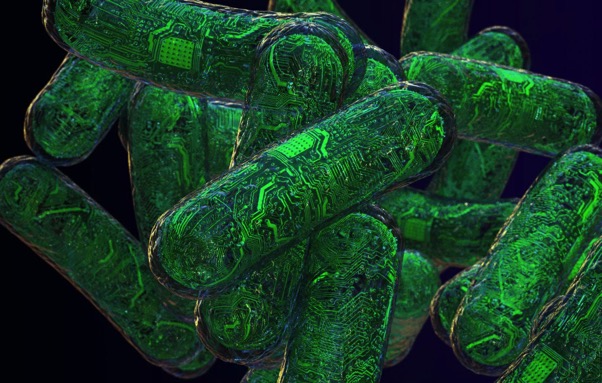The rapid rise of artificial intelligence continues to make machines increasingly human-like, leading to a lot of justified hand-wringing about what will happen to us meatbags once computers are fighting our wars, driving our cars, and breaking stories about the latest developments in artificial intelligence. But what if humans could harness the same digital power and incorporate it into our bodies?
According to new research published today in Nature, a team of bioengineers at Arizona State University was able to do just that. The researchers created a computer circuit out of ribonucleic acid (RNA), the molecule found in every living cell that regulates the process of using DNA to make proteins, that could be programmed to make proteins only under certain conditions. This could pave the way for everything from cheap diagnostic tools for viruses like Zika to programmable cancer-hunting nanobots.
Videos by VICE
Like DNA, RNA is composed of four different nucleotide bases—Adenine, Guanine, Cytosine and Uracil. Unlike DNA, however, RNA isn’t a double helix made from pairs of nucleotides, but is more akin to a chain, where each link in the chain is bound by one of the nucleotide bases. Importantly, RNA nucleotide bases can only link up with one another in certain patterns: A always pairs with U, and C always pairs with G.
RNA plays a number of roles in the process of using DNA to make proteins, but two of the most important are transcription and translation. Transcription refers to the process by which a certain segment of DNA is transcribed into a corresponding chain of RNA, to create a sort of expendable copy of that DNA segment. This chain of RNA is then transported outside of the cell’s nucleus that is the DNA’s permanent home, where it the RNA is used as a sort of instruction manual for building proteins.
Each type of protein requires a specific set of instructions (or RNA nucleotide sequence) in order to be created, just like building a car would require a vastly different set of instructions than building a bookcase, for instance. The idea behind the new RNA circuits is to only trigger protein synthesis when the RNA circuit registers a specific base pair matching as dictated by its programming. This is just like a normal computer, which receives an input (in this case, a nucleotide base), and based on the instructions provided in the computer program produces an output specific to that input (in this case, a protein).
More From VICE: Post-Antibiotic World
To make this happen, the researchers created three types of computer circuits—known as logic gates—out of RNA: an AND gate, an OR gate, and a NOT gate. The AND gate only produces an output when two specific RNA nucleotides are present. The OR gate produces an output when one of two specific RNA nucleotides present. Finally, the NOT gate will prevent any output if an RNA nucleotide is present. Just like a computer, these simple logic gates can be combined to create circuits capable of solving complex computational problems based on multiple inputs. In the case of the living computers created by the researchers, each RNA circuit is programmed to produce a specific protein.
Due to the predictable pairing of RNA nucleotide bases, the researchers were able to make these RNA circuits self-assemble in E.coli bacterial cells. These circuits basically lie dormant until they are triggered by an RNA strand that matches the required input of the particular circuit. The circuit then executes its program and produces the desired protein as an output.
“We’re using very predictable and programmable RNA-RNA interactions to define what these circuits can do,” Alex Green, a bioengineer at Arizona State, said in a statement. “That means we can use computer software to design RNA sequences that behave the way we want them to in a cell. It makes the design process a lot faster.”
This research represents the culmination of work that began back in 2012, and Green suspects that it will have profound applications for the development of smart medicines, green energy production, and eventually bio-based nanomachines that are deployed to destroy cancer cells. Already, Green and his colleagues have used similar RNA-circuit technology to detect the Zika virus in biological samples.
The next step, according to Green, would be the creation of RNA-based neural networks in cells that would be capable of analyzing input levels and only producing an output once a certain level of activity in the cell is reached.
Read This Next: In the Future You’ll Swallow Your Fitbit




